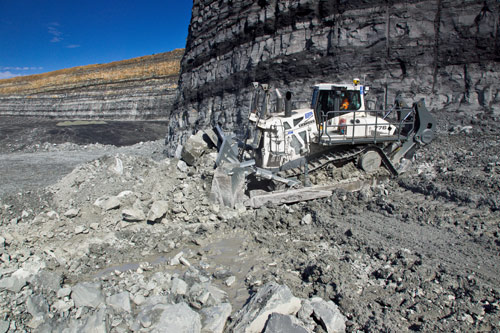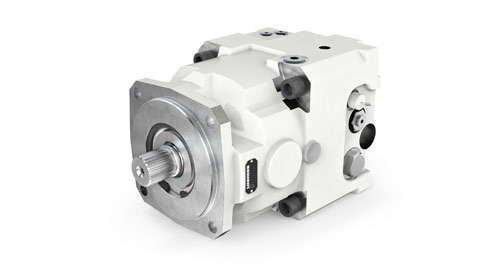The PR 776 is the world’s largest hydrostatic crawler tractor.
 Crawler dozers are designed for tough mining, quarry, and construction operations. And like other equipment at these sites, the machines continue to get bigger as producers demand ever-increasing productivity at lower costs.
Crawler dozers are designed for tough mining, quarry, and construction operations. And like other equipment at these sites, the machines continue to get bigger as producers demand ever-increasing productivity at lower costs.
As such, Liebherr, with U.S. headquarters in Newport News, Va., recently unveiled the
PR 776, its first offering of this type in the 70-ton category. Introduced into the American market late last year, it’s reportedly the world’s largest hydrostatically powered crawler tractor.
Infinitely variable drive
Competitive machines of this size typically rely on mechanical drives, such as a three-stage gear transmission with a torque converter and differential, explained Klaus Graner, Managing Director of Liebherr Components in Biberach, Germany. What sets the PR 776 apart is that, like all Liebherr crawler dozers, it instead uses an infinitely variable hydrostatic drive.

As a bit of background, a basic hydrostatic transmission consists of a hydraulic pump supplying high-pressure flow to a hydraulic motor which, in turn, propels a wheel or track drive. It includes all the necessary fluid conduits, connectors and controls. The systems are a proven means of power transmission that offer smooth and stepless adjustment of speed.
In concept, mechanical-gear transmissions are more efficient than hydrostatic transmissions. However, that assumes a vehicle operates within a relatively narrow range of required torque and speed. Once the operator selects a gear ratio in a mechanical transmission, vehicle speed can only be changed by varying engine speed. When the engine reaches maximum revs, the transmission must shift to a lower-ratio gear. The need to shift gears in mechanical designs interrupts power flow and traction, and it typically means large swings in engine speed, which wastes fuel, noted Graner.

“Normally, a gear box should offer good efficiency but, of course, the engine is not always at the perfect point,” he said. And to smooth the drive output, a torque converter is essential, but energy losses here can be sizeable as well, he added.
In contrast, the hydrostatic drive lets the operator continuously vary vehicle speed from creep to maximum with seamless and continuous power transmission to both tracks. That’s particularly advantageous when pushing a load under full power or climbing hills.
It’s also extremely efficient, said Graner. Hydraulic servo pressure and flow are based on-demand. Electronic control of the system adjusts travel speed and drawbar pull to match load conditions. If full flow and pressure are not required, the load-sensing system automatically dials back hydraulic output and conserves energy. Likewise, in low power-demand situations the pump can increase output and let the dozer move at high speed without increasing engine speed.
Add to that, the hydrostatic transmission lets the PR 776 engine run at a lower speed—about 1,600 rpm—which further improves fuel efficiency, said Graner. Actual field data show fuel saving in the PR 776 of 15% to more than 20%, compared to competitive machines in this class performing similar tasks, he said.
Controllability

Another benefit to the user is simple and straightforward operation. For example, joystick movement signals the pumps to vary output and speed up or slow down the vehicle. Similar commands move the swashplate over center and reverse flow to the motor, and let the vehicle change direction with simple fingertip control.
Maneuverability improves, too. The hydrostatic travel drive operates smoothly and automatically adjusts working speed to load conditions. Engine power always transmits to both tracks without interruption for fast and precise steering. This also minimizes track slip and lets operators concentrate on the work at hand.
It even offers pivot-turn capability. Powering one track in each direction (forward and back) lets the machine turn on the spot. This differs from other designs that power the outside track and brake the inner and require wider, more time-consuming turns. “The maneuverability of this machine is by far superior to a torque-converter drive,” said Graner.
The PR 776 has the added advantage of dynamic braking. Thanks to the self-locking nature of the hydrostatic drive, moving the joystick to neutral signals the pump to destroke and center the swashplate, which brings the machine to a halt. On slopes, the system ensures that the machine doesn’t roll backwards. An automatically activated parking brake provides additional safety.
Matched components
The PR 776’s low fuel consumption and excellent controllability are due in large part to “perfect matching of components,” explained Graner. That includes not only those that make up the hydrostatic drive, but the electronic hardware, software and engine—and how they all interact.
For instance, thanks to common-rail fuel injection and optimized cylinder management and combustion, the latest generation of Liebherr diesel engines works efficiently at low speeds. Drivetrain-system expertise, in turn, ensures the hydraulic pumps and motors are matched precisely to the diesel engine.
And critical to all this is the control logic and programming, said Graner. Sophisticated algorithms were developed that match hydrostatic-drivetrain performance characteristics with engine output capabilities, as well as application considerations like operator demands and operating conditions.
The proprietary electronics and software combine in a modular platform that is scalable for small and large machines alike, and is used in other equipment like wheel loaders and excavators.

in the hydrostatic system.
It’s also notable that the company not only designs and manufactures drivetrain components for its own machines, but also supplies them to many customers outside the Liebherr group.
The end result is that the system’s electronically controlled hydrostatic power and torque output deliver excellent traction and rapid response, while the “intelligent” engine-management system maintains constant engine speed and increases overall efficiency and performance of the PR 776. All these measures lead to significantly lower fuel consumption compared with conventional machines handling similar tasks.
System details
The PR 776’s hydrostatic circuit includes several main components. A splitter box off the engine drives pumps for the travel drive (as well as for the work hydraulics). The closed-circuit system for each track requires two 280-cc DPVG swash-plate pumps supplying two 370-cc DMVA swash-plate hydraulic motors. Feed pumps and control and relief valves augment the circuit.
 The variable-displacement, axial-piston pumps are rated for a maximum speed of 2,500 rpm and volumetric flow of 709 lpm. Nominal rated pressure is 450 bar and maximum pressure is 500 bar. The design includes a hydrostatic swash-plate cradle bearing, and the pumps are built for heavy-duty loads with high reliability and long service life, according to the company.
The variable-displacement, axial-piston pumps are rated for a maximum speed of 2,500 rpm and volumetric flow of 709 lpm. Nominal rated pressure is 450 bar and maximum pressure is 500 bar. The design includes a hydrostatic swash-plate cradle bearing, and the pumps are built for heavy-duty loads with high reliability and long service life, according to the company.
The variable, axial-piston motors have a nominal pressure rating of 400 bar and maximum pressure of 450 bar. Maximum speed at a ΔP of 430 bar is 2,400 rpm, and maximum rated flow is 888 lpm. Like the DPVG pump, it’s noted for high performance, ruggedness and efficiency.
Both pump and motor feature an inverted-piston design with a 22° swivel angle. The high swivel angle increases the conversion range and efficiency of the pumps and motors. Further, the compact rotary group and high-pressure capacity contribute to high power density. These pumps and motors are also used in related equipment like mining excavators and maritime cranes.
Robust and durable final drives on the PR 776, powered by the hydraulic motors, are designed to handle extreme loads typical of mining operations. The units combine spur and planetary gears, and include onboard temperature monitoring and double duo-cone transmission seals.
Additional features
The hydrostatic drive depends on high-quality hydraulic pumps and motors that help ensure the vehicle operates reliably and with minimal wear. Unlike mechanical transmissions, the proven travel drive does not require more-problematic components such as a torque converter, multi-ratio transmission, service brakes or steering couplings. And by design, the hydrostatic system can be stalled without damage.
Liebherr hydraulic fluids permit service intervals as high as 8,000 hours of operation. These oils reduce friction, provide corrosion protection and offer excellent compatibility with hydraulic hoses, seals and gaskets. Thus, the fluids cut downtime, improve machine availability and, by minimizing resistance between moving parts, reduce fuel consumption.
Electronically controlled hydrostatic fans regulate hydraulic-fluid and engine temperatures. Fan speed adjusts to operating requirements, which helps save fuel and minimize noise. An optional, reversible fan automatically cleans the radiator and coolers in dusty work environments.
In the past, dozers were viewed as rather difficult earthmoving machines to operate. The PR 776’s cab and operating platform helps ensure uncomplicated and safe operation. Not only do the ergonomic joysticks direct dynamic outputs like speed, steering and blade functions, adjustable settings let the operator tune the degree of control from delicate to aggressive, as needed.
The instruments and operating controls are organized for easy reach. For instance, the new PR 776 comes with an ECO function that lets the operator choose between maximum power for high performance and maximum efficiency in light-duty operations for greater fuel savings. Other settings like automatic engine-speed reduction, travel-drive response, and steering parameters as well as standard safety functions such as the rear-view camera can be all be accessed through the intuitive touchscreen display. All in all, the workspace is designed to minimize stress and strain on the operator and, in turn, improve overall performance and productivity.
Finally, the PR 776 comes with LiDAT, Liebherr’s vehicle and fleet data management system, which provides critical information on vehicle location, operation and health. For example, the system supplies information such as vehicle uptime, operating demands and fuel consumption. It also offers remote monitoring, tracks overloads and faults, initiates alarms, notes service intervals and facilitates proactive maintenance. Technicians can even log into the machine controls from any location and pinpoint faults and help correct malfunctions.
Liebherr
liebherr.com


Prior generation dozers WERE INDEED a challenge to operate, that is certain. So with a lot of brains in the control system this model should do a much better job much more simply.
But one added benefit was not listed, which is the ability to service the drive system in a modular manner, instead of doing a whole tear-down to repair a mechanical transmission. Of course, that was not mentioned because none like to admit that their equipment would ever need service, but sometimes service is indeed needed, and changing out one module could be a lot faster than a complete tear down.